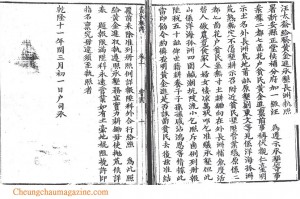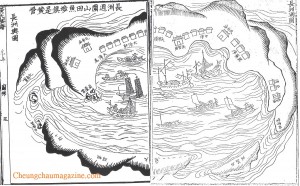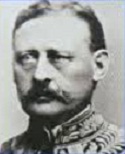1898 Jan 01
Land Court , 1900
1900 Jan 01
Land Court , 1900
Since the issue of Chinese Notice in 1899 by the Governor, Henry Blake, informing all land owners in New Territories and Outlying Islands to claim land ownerships, Colonial Government received great amount of land claim disputes, amounting to 69,253 cases, as reported by Stewart Lockhart in his report to Government in 1902.
(參閱 : Ching Dynasty New Territories and outlying islands Land Tenure, before 1898)
Colonial Government enacted the No 18th Ordinance in Hong Kong, the Land Court Ordinance to establish Land Court to handle all theses claim disputes.
Mr. H E Pollock was appointed President, Mr. Gompertz was appointed member, and Mr. Kemp appointed as Registrar.
“ First sitting of Land Court did not take place till 20th February 1901 on Ma Wan Island, then frequent intervals to Cheung Chau and Ping Chau.
Mr. Pollock and me also went to Liyumoon to sit in Chinese Temple for hearing, and Cha Kwo Lang to sit in vacant shop for hearing.” remarked by H H J Gompertz as President of Land Court in report to Colonial Government dated 15th March 1902.
(參閱 : British Colonial Government Policy on land administration in New Territories, 1899)
In 1905, Land Court member J R Wood submitted his report to Colonial Government and listed out the chief problems for settlement :
“Many large tracts of land are now claimed by persons who have never paid Crown Rent on them, who never reported their occupation, such as it was to the authorities, and whose claims have never in any way recognised by the Chinese Government.
Very many persons have been paying under the name of tax annual sums to families who professed to be giving an account of these sum to District Treasury but who as a matter of fact very often did nothing of the kind and who in many cases had no real title to more than a very small fraction of the territory over which they collected this rent. “
J R Wood went on to comment “ The claims to large tracts have for the most part on investigation proved untenable, while the Tax-collecting families or Taxlords, as we have called them., have , where they can show documents in support of their income of any part of it, been provided for in ways appropriate to each case on recommendations of the Court.”

Wong Wai Tsak Tong Clan’s book land title record |

Wong Wai Tsak Tong clan’s book land title record |

Wong Wai Tsak Tong clan’s book land title record |
Please response to this post, your comment is important to us
British Colonial Government Policy on land administration in New Territories, 1899
1900 Jan 17
British Colonial Government Policy on land administration in New Territories, 1899
Bruce Shepherd, then Deputy Land Officer, stated clearly in his report to Government dated 17th January, 1900, of British Colonial Government Policy in land administration in New Territories.
The policy would be based on the Land Registration Ordinance of 1843, requiring all land owners to register their land ownerships from Ching Dynasty, they would then be issued title deeds for a period of 99 years.
Henry Blake, the Governor, issued a Chinese notice on 12th July 1899 informing all land owners of New Territories and Outlying Islands to file their claims of land ownerships.
Stewart Lockhart emphasised all owners ought to bring along their Ching Dynasty title deeds in person, submit the filled-in claim form to visiting officer to the village.
A list of land owner names would be posted in the village for 7 days. If there was no dispute, a certificate of title would be issued to individual owner after payment of Crown Rent.
If there were disputes, the case would be passed on to Squatters Board for examination and the outcome would be decided by Governor.
All land in New Territories would be surveyed for its size and exact location, land not claimed would be British Colonial Government land.
“ Do not say that I have not warned you here, do not show disobedience.” Henry Blake.
 |
 |
|
English Land Claim Form |
Chinese Land Claim Form |
Please response to this post, your comment is important to us
Wong Wai Tsak Tong, Cheung Chau
1905 Jan 01
Wong Wai Tsak Tong, Cheung Chau
Wong Wai Tsak Tong was land owner of 90% of private land on Cheung Chau.
According to Wong Wai Tsak Tong’s clan book, the Tong originated from Po Tin area of Fujian (Fookin) province around Southern Sung Dynasty, (A.D.1127-1279), then moved to Guandong (Canton) from Fujian and settled down in the province.
Further to Land Claim in 1899, the Hong Kong Colonial Government registered Wong Wai Tsak Tong in 1905, in the form of Block Crown Lease as owner of 90% of private land on Cheung Chau.
Wong Wai Tsak Tong then issued 5-year lease for land to individual owners, and also collected payment of Crown Rent and paid to Hong Kong Colonial Government.
This practice went on till 1995 when a legislation, Block Crown Lease (Cheung Chau) Ordinance, passed to terminate Wong Wai Tsak Tong as the Taxlord for Hong Kong Colonial Government on Cheung Chau.
In the press release from Hong Kong SAR Government dated 25th of May in 2011, in response to query from Mr. Tsim Pui-Chung , Legislative Councillor of Legislative Council, Mrs Lam Cheng Yuet-Ngor, Chief Secretary of Hong Kong SAR Government, clearly stated that “a sum of HK$20.0 millions have been made to Wong Wai Tsak Tong in 2004 as compensation, which is not calculated on basis on size of land. There were no legal process involved in recovering Cheung Chau land from Wong Wai Tsak Tong.”
She also said “Block Crown Lease (Cheung Chau) Ordinance, passed in July in 1995 has terminated Wong Wai Tsak Tong status on Cheung Chau legally, and all sub-lessee from Wong Wai Tsak Tong will become lessee of Hong Kong SAR Government.”
Wong Wai Tsak Tong, however, remains as the biggest land owner and landlords on Cheung Chau, according to Land Registry of Hong Kong SAR Government.

Cheung Chau Map, 1874 Wong Wai Tsak Tong Clan’s Book |
Please response to this post, your comment is important to us
The number of posts displayed per page : 5




